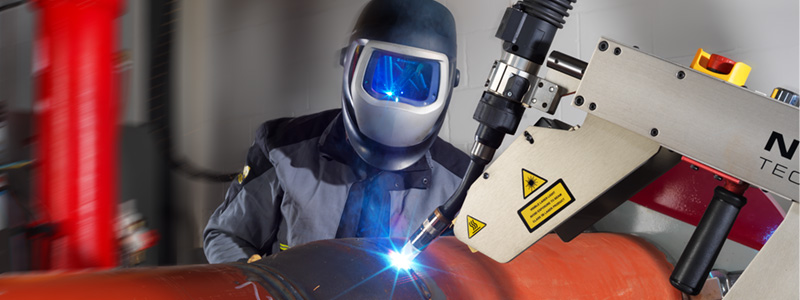The term digitalisation of production is first and foremost associated with optimising processes in order to increase profitability. But digitalisation goes much further and opens up opportunities for more sustainability. This is a goal that every company must pursue nowadays.
Digitalisation in welding technology: the opportunity for more sustainability
Topics: automation, research & development
How does digitalisation affect welding technology?
Digitalisation is often equated with automation. People think of jobs disappearing because robots or other machines replace human work. But if you take a closer look, the situation is completely different. Digitalisation and automation differ fundamentally.
Topics: automation, research & development
Why is narrow-gap welding sustainable?
Pipeline construction, shipbuilding, tank construction – where thick sheets are welded together, the welding equipment is put to the test. Several layers of filler metal have to be applied on top of each other and the extreme heat development puts additional strain on the welding equipment. Those who can use narrow-gap welding for this purpose really do act sustainably.
Topics: automation
How does laser welding work?
Nowadays, laser welding has long been a standard process, which is used, for example, in automobile production, steel construction as well as in the aerospace industry. The principle of laser welding is "light amplification by stimulated emission of radiation" and means that light is generated with only one wavelength. The high energy density of 105 up to 106 Watts per square centimetre generated in this way is exploited technically in welding: the high energy density of a laser beam is applied to a small spot, creating the possibility of contactless welding at high process speed.
Topics: automation, research & development
How to achieve more efficiency in pipe welding
Looking at a classic pipe welding company, the following picture usually emerges: pipe sections are lying on the hall floor, individual pipe sections are placed on trestles and are welded together at individual workstations by a welding specialist. Root welding, layer welding, cover layer welding – everything is done manually and costs time. These companies are finding it increasingly difficult to meet their customers' deadlines, because the shortage of skilled workers is omnipresent. Even if an employer is lucky enough to have enough welders available, delivery times often cannot be kept because production takes too much time. Even personnel costs are out of proportion when the order situation is good, if efficiency cannot be increased to meet the required order volume. Many pure pipe welding companies are therefore faced with high automation pressure.
Topics: automation
How can pipes be welded more economically?
Pipeline construction is a tough business that depends on quality and speed. Especially in the construction of onshore pipelines, there are still more than 90 % welders who weld the pipes manually. The pressure for welders is particularly high in this production sector because:
Topics: automation
Automation in welding technology – what does that really mean?
At a certain point in time, it is essential to switch your welding production from manual to automated welding. Increasing quantities, short delivery times and high quality requirements then leave no alternative. Last but not least, every employer wants to protect their welding specialists from monotonous work. However, the step into automation is not always easy and must be well thought out. But what exactly does automation mean in welding technology?
Topics: automation

/WeldProf/WELDPROF_News/Digitalisation%20in%20welding%20technology%20-%20the%20opportunity%20for%20more%20sustainability/AdobeStock_504341882_800_300.jpg)

/WeldProf/WELDPROF_News/2023_how_does_digitalisation_affect_welding_technology/AdobeStock_220790568_digitalisation_banner.jpg)
/WeldProf/WELDPROF_News/Why%20is%20narrow-gap%20welding%20sustainable/narrow_gap_welding_teaser.jpg)
/WeldProf/WELDPROF_News/Laser/2022_WELDPROF_Laser_Masterfeeder_banner.jpg)

/WELDPROF_News/ABIBUG_300_Service_Action_62_800x300.jpg)
/WELDPROF_News/Automation_WELDPROF_800x300.jpg)